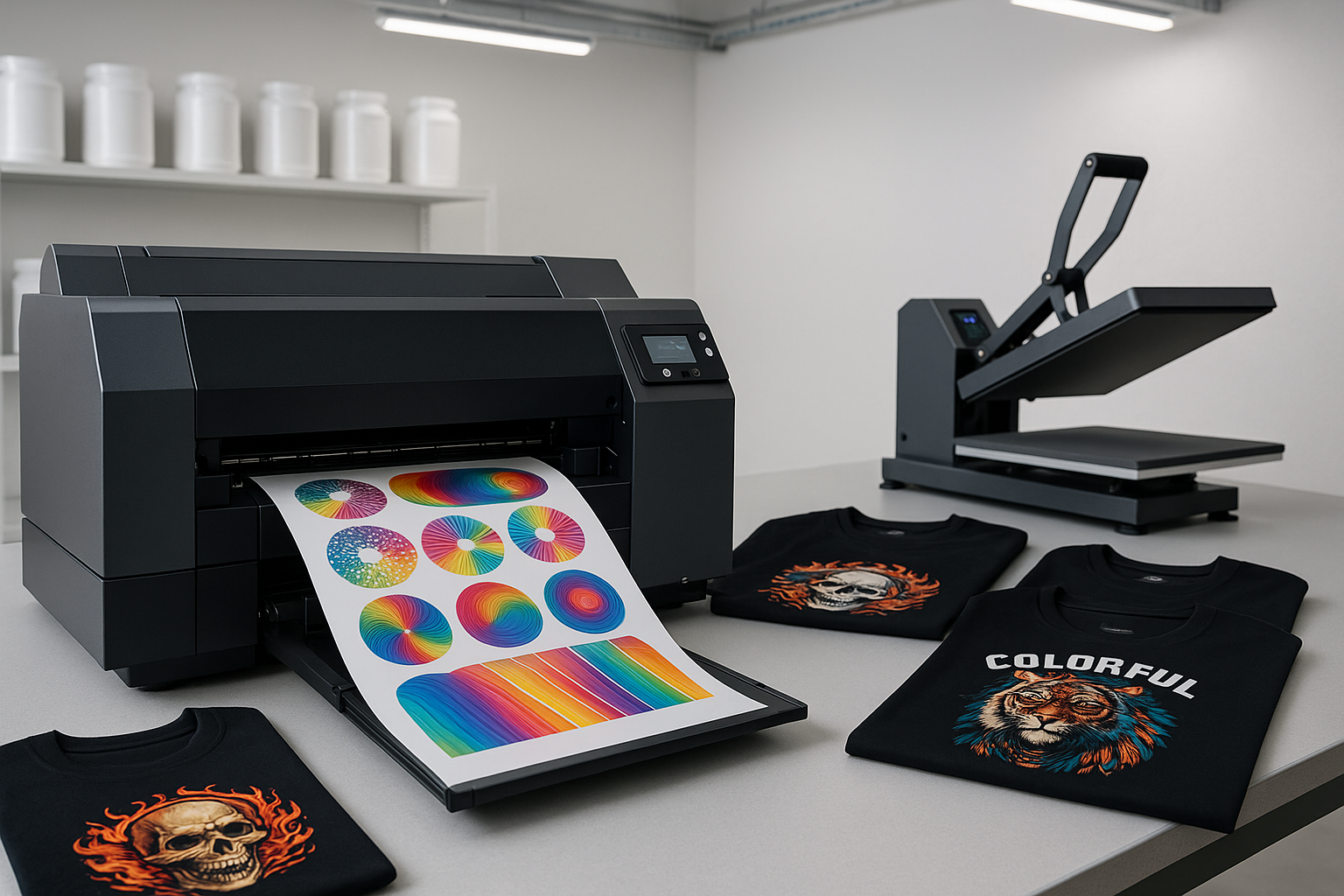Your Comprehensive Guide to Perfecting Every Print
Direct-to-Film (DTF) printing has revolutionized custom apparel and product decoration. With vibrant colors, versatility across materials, and no need for pre-treatment, it’s no surprise that DTF has become a go-to method for small businesses, hobbyists, and large-scale print operations alike.
But while DTF printing offers impressive advantages, achieving consistent, high-quality results requires a deep understanding of the process, from design preparation to final pressing. In this blog, we’ll walk you through expert tips and proven practices that will help you produce professional, durable, and stunning DTF prints every time.
Understanding the DTF Printing Process
Before we dive into quality tips, it’s essential to understand what DTF printing involves. The DTF process uses specialized printers and inks to print designs onto PET film. After printing, the design is coated with hot melt adhesive powder, cured, and then transferred onto a surface using a heat press.
The Core Steps:
- Print the design onto a DTF film using DTF inks.
- Apply adhesive powder while the ink is still wet.
- Cure the powder using a curing oven or heat press.
- Heat press the design onto the desired substrate.
- Peel the film (hot or cold peel depending on the film type).
Now, let’s look at what you can do at each stage to ensure top-tier results.
Set Up Your Workspace for Success
A well-organized, clean, and temperature-controlled workspace is the foundation of great DTF output. Environmental factors like dust, humidity, and temperature swings can directly affect print quality.
Pro Tips:
- Keep your workspace clean and dust-free. Any dust particles that land on wet ink or adhesive powder can compromise the final print.
- Maintain room temperature between 70–80°F (21–27°C) and humidity around 40–60% for consistent results.
- Avoid placing your printer or curing oven near open windows or vents, which can affect airflow and temperature stability.
Choose High-Quality Materials
The quality of your input materials (film, powder, inks) will significantly influence the final output. Don’t cut corners here.
What to Look For:
- Use double-sided coated film for better ink adhesion.
- Make sure the film is anti-static to reduce dust attraction.
- Choose the appropriate peel type: hot peel for faster production, cold peel for more delicate or intricate designs.
DTF Inks
- Use pigment-based DTF inks specially formulated for your printer model.
- Look for inks that produce bright, opaque whites and vibrant colors.
- Store inks in a cool, dark place to avoid spoilage or separation.
Hot Melt Powder
- Choose fine-grain powder for smooth edges and minimal residue.
- Make sure it melts evenly and creates a strong, flexible bond with fabric.
- Store it in an airtight container to prevent clumping or contamination.
Perfect Your Artwork Preparation
The quality of your final print starts with your design file. Poorly prepared artwork will always yield disappointing results.
Tips for Flawless Art:
- Use 300 DPI resolution or higher.
- Convert artwork to CMYK mode and adjust saturation/contrast for DTF output.
- Mirror the design before printing, especially for text-based graphics.
- Use vector graphics when possible for crisp detail.
- Check for clean edges and avoid low-resolution elements that can pixelate.
RIP Software:
A reliable RIP (Raster Image Processor) is essential. It handles color separation, white underbase layering, and ink flow.
- Set white underbase settings properly: too much white = stiffness; too little = poor opacity.
- Use RIP to optimize ink density, especially for darker garments.
Calibrate Your Printer Properly
Printer calibration is one of the most overlooked factors affecting DTF quality.
Critical Printer Settings:
- Perform regular nozzle checks to avoid banding.
- Set your ink limits per color (CMYK+White) based on your media and ink brand.
- Align your printhead to ensure perfect layer registration between colors and white.
- Run periodic cleaning cycles to maintain ink flow and prevent clogs.
Use test prints often to confirm print quality before running full jobs. Don’t waste film on preventable errors.
Master the Powdering Process
Applying and curing adhesive powder correctly is critical. This is where most beginners make mistakes.
How to Apply Powder:
- While the ink is still wet, evenly coat the printed film with powder.
- Shake gently to remove excess and ensure the design is fully coated.
- Avoid touching the printed side during this process.
Curing the Powder:
- Use a curing oven set to 300–320°F (150–160°C).
- Cure for 2–3 minutes until the powder melts and the ink is dry.
- If using a heat press to cure, hover (don’t press) over the film with a gap of ½ inch for 60–90 seconds.
Undercuring leads to poor adhesion. Overcuring causes the powder to become brittle or yellowed.
Heat Press Like a Pro
Once the design is cured and ready, the transfer onto the substrate must be executed with precision.
Heat Press Settings:
- Temperature: 300–325°F (150–160°C)
- Time: 10–15 seconds
- Pressure: Medium to firm
Every fabric behaves differently, so it’s important to test press new materials before doing bulk orders.
Peel Strategy:
- Cold peel films: Wait until the film is completely cool before peeling.
- Hot peel films: Peel immediately but smoothly in one motion.
After peeling, repress for 5–10 seconds with a Teflon sheet to ensure long-lasting durability and finish.
Troubleshooting Common DTF Issues
Every printer runs into problems at some point. The key is knowing how to identify and resolve them quickly.
Issue: Banding or Lines in Prints
- Check for clogged nozzles.
- Align printheads.
- Reduce printing speed slightly for better control.
Issue: Adhesive Not Sticking
- Check curing time/temperature.
- Make sure the powder was applied evenly and completely.
- Increase pressure during pressing.
Issue: Colors Look Dull
- Use RIP software to boost color saturation.
- Ensure correct ink profiles are being used.
- Avoid using old or expired inks.
Issue: Film is Hard to Peel
- Confirm whether you’re using hot or cold peel film.
- Check press temperature and time.
- Allow proper cooldown for cold peel films.
Maintain Your Equipment Like a Professional
Ongoing maintenance is not just smart — it’s necessary for consistent results.
Daily Maintenance:
- Run a nozzle check before each session.
- Shake white ink cartridges (if applicable).
- Wipe the printhead cap station and surrounding areas.
Weekly Maintenance:
- Deep clean capping station, wiper blade, and encoder strip.
- Inspect dampers and ink lines for air bubbles or blockages.
Monthly Maintenance:
- Flush ink lines if needed.
- Update firmware and check RIP software for updates.
Proper maintenance prolongs the life of your printer and protects your investment.
Finishing Touches for Premium Results
Once the transfer is complete, don’t forget the finishing touches that make your product shine.
Quality Control Checklist:
- Inspect for ink smudges, dust, or discoloration.
- Confirm all edges are fully adhered.
- Check the durability of the print with a stretch or wash test (for test prints).
Add Professional Packaging:
- Fold garments neatly.
- Add hang tags or branding labels.
- Consider inserting care instruction cards.
Advanced Pro Tips for Going Beyond Basic Prints
Want to truly stand out from competitors? Consider these advanced techniques:
Use Special Effect Inks
- Fluorescent, glitter, or metallic inks can be used in certain DTF workflows for standout visuals.
Multi-Color Layering
- Try layering multiple prints to create texture or depth.
- Offset prints intentionally for a “shadow” or drop effect.
Hybrid Printing
- Combine DTF with embroidery, screen printing, or DTG for unique textures and effects.
Color Profiling
- Create your own ICC profiles using color calibration tools to dial in consistent colors across jobs.
DTF printing offers an incredible combination of color, durability, and versatility — but only when executed with care and precision. By understanding every step of the process and applying the tips above, you can elevate your work from average to exceptional.
Whether you’re a small business owner, a print shop, or a passionate creative, mastering these DTF techniques will not only reduce waste and errors but also build your brand reputation for quality and reliability.
Ready to Level Up?
At DTFSuperPrint.com, we’re committed to helping you produce your best work. Whether you need top-quality DTF transfers, heat presses, inks, or films — we’ve got the tools and expertise to support your journey.
Stay creative, stay consistent, and never stop learning.
Happy Printing!

